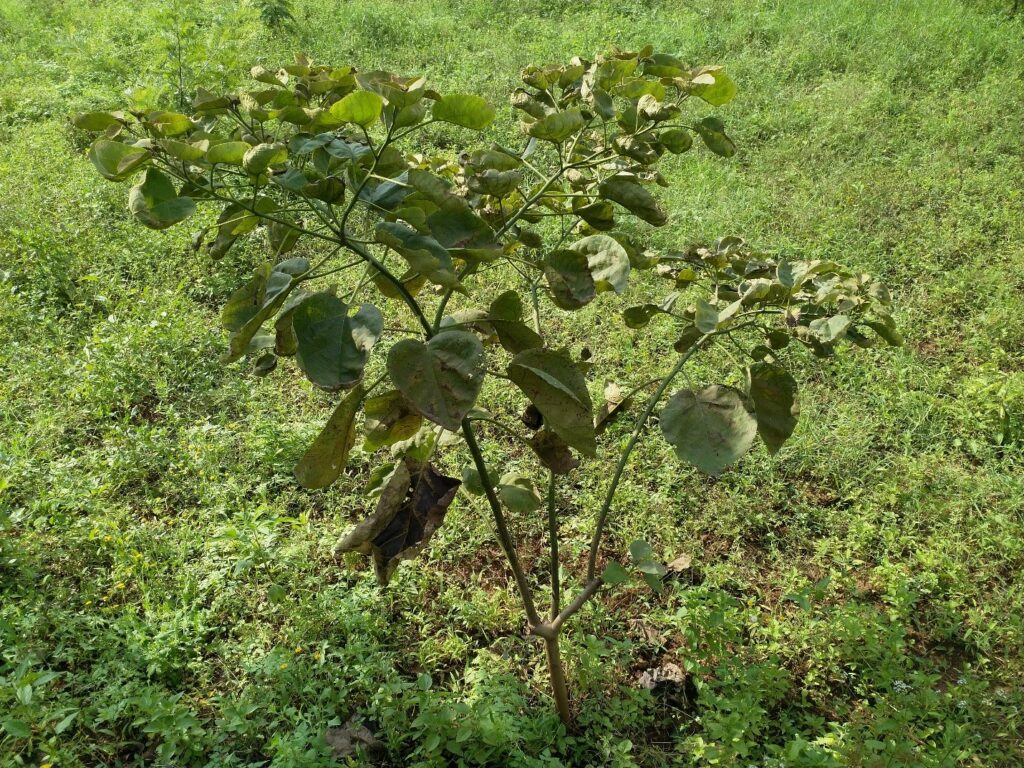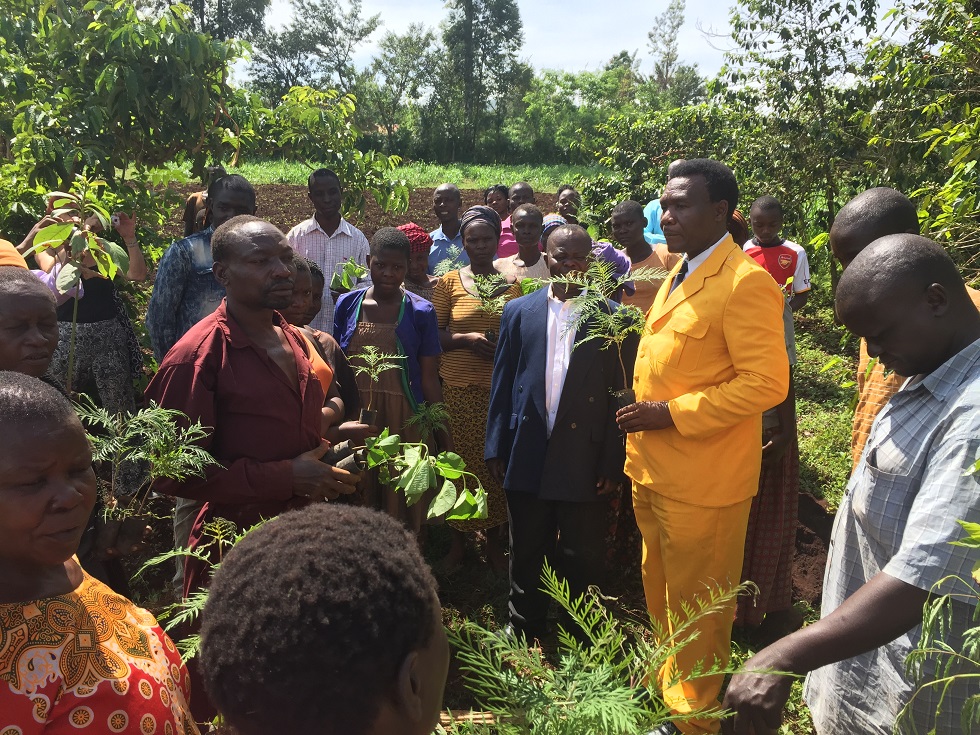By Prossy Nandudu
Mount Elgon region is one of the areas with fragile ecosystems characterized with mudslides, landslides and flooding.
During flooding, water washes away top soil full of nutrients needed for plant growth. It means that farmers have to apply fertilizers to restore lost fertility.
But because the cost of fertilizers is high alternatives such as intercropping food crops and trees also known as fertilizer trees could be the solution. This according to experts in soil health and nutrient management.
Additional information from the Food and Agriculture Organization (FAO), explains that the practice of intercropping trees and crops is one of the promising ways of addressing social, economic, and environmental challenges.
The practice can also lead to increased farm productivity, improved water management in gardens on slopes of mountains among others, adds FAO findings.

Need for trees
Because of Elgon’s fragile nature, researchers from the National Forestry Resources Research Institute (NaFORRI) through the Agroforestry Research Program are promoting agroforestry trees in the region to restore lost nutrients in the soils as well as bind the soils together to prevent erosion. As they prevent erosion, their root nodules that have nitrogen replace lost nutrients in the soil.
According to Dr. Joel Buyinza, a forester and researcher from NaFORRI, the trees being considered are Albizia coriaria (Kumulukhu in Lugisu and Mugavu in Luganda) Cordia Africana Chihikiri in Lugisu and Mukebu in Luganda Measopsis (Musizi in Uganda and eminii in Lugisu).
The selected trees are also known as fertiliser trees because they have root nodules that contain bacteria called rhizobia.
The rhizobia fix nitrogen in the soil and make it accessible by crops. Additionally, when the leaves of these trees fall and decompose, they form a rich organic matter which can also be accessed by crops.
Naturally generated fertilisers enable farmers to manage costs as they no longer have to buy inorganic ones whose prices have been increasing since the COVID-19 pandemic, especially the lockdowns that disrupted manufacturing in most parts of the world.
Apart from improving soil fertility, the trees will provide firewood, charcoal and poles for construction. The trees also act as source of incomes where farmers sell some tree products to generate additional household income.
Growing trees on the farm will also protect existing naturally growing trees, threatened with the growing demand for fuel wood and construction.
The Ministry of Water and Environment’s 10-year action plan for the restoration of degraded environment, reported that the forest cover decreased from 53% in 1900 to 24% in 1990 and then 12.4% in 2017, representing a loss of 2.4 million hectares during the period.
The major drivers of deforestation are agricultural activities, urban settlement, unsustainable timber and wood extraction, wild fire and weak enforcement among others, adds the document from the ministry.
Best tree planting practices
Given the fact that the region is fragile, Buyinza explained that for steep areas like Elgon, Kigezi and Rwenzori areas, terraces have been established to support the weight of fruit trees.
The team has chosen grafted trees that even when they over grow, they don’t exert much pressure on the terraced areas until the roots have been firmly established in the soils.
Other conservation plants being promoted alongside the agroforestry trees are shrubs like Calliandra, which is also animal fodder, Napier grass as well as Makuna plant, Buyinza explained.
The agroforestry trees are being planted in Manafwa, Bududa and Mbale districts in eastern Uganda, especially in coffee gardens, Buyinza added.

Existing conservation practices
Although the two tree species out of the seven have been highlighted as best for agroforestry, Buyinza said technologies such as fodder banks (where high quality fodder species are planted on boundaries to provide feeds for livestock), boundary planting, riverbank restoration using trees are also being promoted.
Other methods are the scattered tree method on the farm for farmers with small pieces of land, vegetation strips (an area where vegetation is maintained in a garden to remove or sieve out sediment and other pollutants from surface runoff water) and then woodlots to control soil erosion are being promoted in most vulnerable farming communities like Mt. Elgon region.
Sustainability
For the sustainability of the intervention, Buyinza said they have established community tree nurseries and at the NaFORRI Rural Resource Centre in Mbale, which is a one-stop centre for farmers to access information in relation to agroforestry, tree seedlings and training facilities.
“We have trained farmers and have given them a start-up seed to establish their own nurseries. One of the nurseries has since secured a tender from Manafwa district administration to supply seedlings,” Buyinza added.
Trees to avoid while practicing agroforestry
Much as the planting of trees is being encouraged across by government and other stakeholders to restore the tree cover, care must be taken when practicing agroforestry.
Because some trees have been reported by farmers especially in Iganga and Bushenyi districts, that they harbour pests that attack especially coffee plants.
Although there are trees that harbour disease-causing organisms to coffee, these can be managed through pruning.
“To prove to them, we carried out demonstrations on some sites, and the results were clear, trees that were not pruned didn’t have fruit but also they created an environment that favors the growth of pests,” Buyinza explained.
He added that “If there is a pest or fungus and there is this moist area below the trees, the pest will harbour itself there. And below this nice shed, there is some coffee below and its food so pests tend to move to the nearest food point. But if farmers can learn to manage the trees, we shall have solved half of the problem,”
He also admits that some trees are alternative hosts to pests that attack coffee. So when the pest is in coffee it will find the trees also friendly, it will get into the tree or if found in the tree, it will find the coffee friendly to it.
Planting tips for trees
To benefit from agroforestry, spacing of the said trees should be considered because usually have a bigger canopy or crown when mature, for example Albizia coriaria (Mugavu), when mature has a canopy with a diameter of up to 30 metres.
“When planting it means the tree should be far from each, especially farmers with smaller pieces of land. But those with bigger pieces of land, we advise them to plant closer because of the demand for firewood and charcoal, however, thinning should be carried out continuously as the plant grows to limit the shade,” he added.
Without explaining the number of trees recommended in an acre, Buyinza added that spacing should be at 15 by 15 meters for Albizia trees, for small holders for those with larger pieces of land could go for a 10 by 10 spacing but also be thinned further as they grow in their farming systems to avoid over shading the understorey crops.
How to manage the trees in crops
Nuwa Welikhe, the certification and Operations officer at Mt Elgon Coffee and Honey Cooperative, where coffee farmers are intercropping trees in the coffee gardens said that pruning of the trees is done once a year preferably during the dry season to allow in light.
“Failure to prune the trees leads to development of a big canopy or shade which limits crops below from accessing light, leading to poor growth and low yields,” he explained.
Because of stunting and low production in areas where the trees had been planted, Buyinza said that farmers had started removing the trees from their farming systems because of the dense shade within the coffee gardens.
Benefits of planting trees in the crops
Welikhe said planting tress reduces high temperatures in the soils and air, providing a cool atmosphere that is ideal for especially coffee plants. He adds that cool temperatures lead to the development of bigger coffee beans which when processed have a better cup test.
In terms of earnings to the farmer, he explained that coffee grown in the cool temperatures attract more money as these are graded as AAA which is the highly paid grade, AA second and A which is the third grade.
According to Welikhe, their members from areas like Buginyanya, Sipi and Bududa districts usually harvest big coffee beans that are taken to cooperative officers for processing and marketing.
Inters of cost, he said farmers with trees in their coffee gardens are saved from the cost of weeding, fertiliser as the tree shades prevent growth of seeds below but as their leaves drop on the ground, birds excrete on them. These decompose and create organic manure to the soil, when combined with nitrogen fixed in the soil by the trees, farmers are saved from purchasing fertilisers.
Challenges of rolling out agroforestry in Uganda
Despite the success in some areas, the challenge in the promotion of agroforestry as a conservation practice is generally insufficient land, associated with competing land uses amidst a fast-growing human population.
Agroforestry (and generally agricultural) technology adoption has also been inefficient, partly attribute to the current top-down extension approaches, which mainly promote knowledge transfer as opposed to knowledge exchange.
Buyinza advised that transformative extension approaches that promote knowledge pluralism and collective learning should instead be used so that farmers’ knowledge and perspectives are incorporated in the extension materials.
These approaches are currently being piloted among smallholder farmers in the Mt. Elgon region under another Australian Funded project entitled ‘Enabling dialogue in Agricultural Extension for improved productivity of smallholder coffee agroforestry systems in the Mt. Elgon region of Uganda’.
Commenting on the
Kakayi Brenda a coffee farmer under the cooperative says she uses branches of the trees from her coffee garden for firewood and that the trees also protect the coffee from hailstorms.
“I no longer register breakages of coffee trees. I harvest the tree branches for firewood and some construction work at home like making plate stands, chicken houses, cow shades,” said Kakayi.





